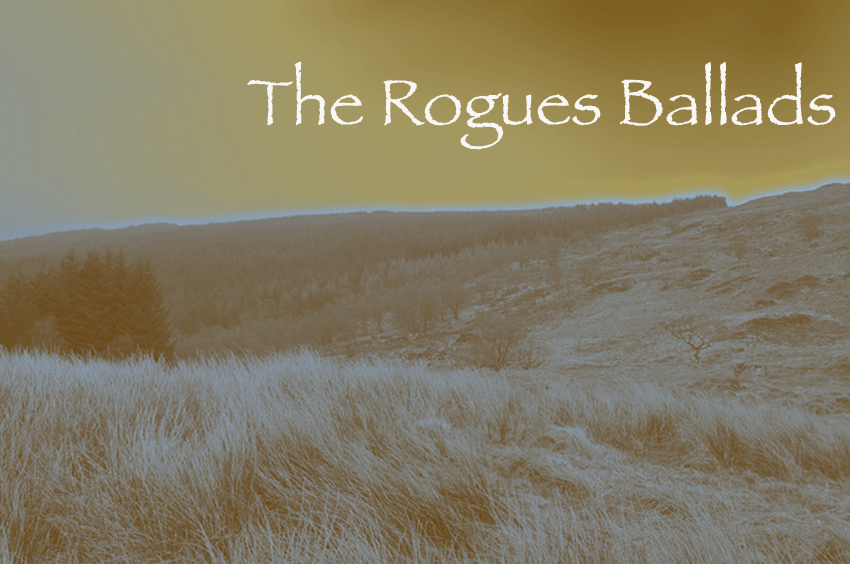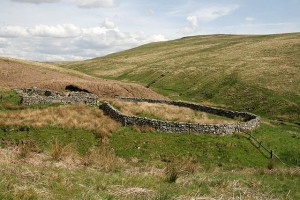Dick o’ the Cow
This ballad had been published prior to the Minstrelsy, in Caw’s Poetical Museum of 1784, although a copy also existed in Percy’s Papers. Scott notes this in his introduction, along with the contributor’s identity, something Caw was more circumspect about. Scott identifies him as Dr. John Elliot of Redheugh, one of his own collaborators. Caw’s introduction to the ballad, which he refers to as a song, includes remarks that it had “long been admired” in the Liddesdale area.
We have included this ballad in the “Rogues” section as the main character is not a reiver, although he fools several of the Armstrong clan, as well as Lord Scrope.
Scott incorporates several of Caw’s footnotes into his supplementary endnotes to the ballad. He quotes the reference to “Cannobie” almost verbatim, changing “border” to “borders”, and adopting “Liddesdale” for “Liddisdale”. He expands Caw’s statement regarding the phrase “St Mary’s knot”: Caw merely notes that this means “Ham-stringed the horses”, while Scott develops the note into an explanation of which horses mentioned in the ballad escaped this attack, and assigns the phrase to “border dialect”. He also updates the information regarding the ownership of Pudding-burn. In Caw’s publication, it was noted that Pudding-burn was part of Readmoss farm, and in the possession of one Mr Henry Elliot of Flat: Scott updates this information, noting that it belonged to the Duke of Buccleuch.
History
There is no evidence that this ballad has any historic provenance. It stands, as does “The Lochmaben Harper” as a fairly light-hearted tale where a character who is perceived to be of too low social standing (or of too low an intellectual capacity) to be regarded with anything but good humour or disdain gets the better of those characters who consider themselves to be his betters. In this case, with the reivers, it is very much a case of the biters bitten.
However, the ballad does contains characters which have historic parallels, such as The Laird’s Jock and Lord Scrope, and locations which have actual parallels. There are references to the main character, Dick o’ the Cow, in other pieces of writing, but it may be that proves more about the age of the ballad than the actual character. Scott’s version has its source in Caw’s Poetical Museum of 1784, which was published in Hawick. Caw declares that it was “long admired by the people of Liddesdale” and owes the debt he has to a “Gentleman of taste, in Liddesdale” who seems to have provided the ballad. Caw places the events between the years 1563 and 1596, due to the inclusion of Lord Scrope within the ballad, and does not consider, in print at least, that the inclusion of actual names could be a means to provide veracity to a rather tall tale.
As well as Lord Scrope, the ballad makes reference to The Laird’s Jock, Fair Johnie Armstrong and Willie Armstrong.
The pivotal action within the ballad takes place at Puddingburn, an Armstrong hold, which was recorded in documents and also mapped (see below). The ruins are still visible.
The Characters
There are two characters mentioned in the ballad which have historical parallels.
The Laird’s Jock
The Laird’s Jock is mentioned in Thomas Musgrave’s missive to Lord Burghley, which states that he lives “under Denyshill besides Kyrsope in Denisborne” (Calender of Border Papers I: 121), and the location is noted on the “platt” created for Lord Burghley around 1590, lying on the Tinisburne. The Laird’s Jock is also cited in “Sir Richard Maitland’s Complaynt Aganis the Thievis of Liddesdail”, which Scott includes as Appendix II in the 1802 edition:
Thay spuilye puir men of their pakis,
Thay leif them nocht on bed nor bakis;
Baith hen and cok,
With reil and rok,
The Lairdis Jok
All with him takis.
In 1584, Thomas Phillips wrote of the need for the “100 Berwick foot to lie at Cresoppe [Kersope], and assist to keep down the Armstronges of Tinnes alias Puddyborne, the Whithaches and Mangertouns, and Elwoods [Elliots].” (CBP I 168).
Fair Johnie and Willie Armstrong cannot be assigned any distinct historic parallel. However, they operate as characters typical of any average reiver – even taking the bedsheets off the bed, just as the “theivis” do in Maitland’s poem.
Lord Scroope
Henry Scroope became West March Warden in 1563, with his patents as both Warden and Captain being granted on 6 April 1563 (C. Pat. Rolls, Eliz. 1-16, fol. 102, 103) and he died in office on June 13 1592 (Dom. Add. iii, 341). It should also be noted that while The Laird’s Jock had a brother called John, he is not referred to as “Fair” in any of the extant Warden letters, and that Puddingburn – also referred to as Tinnies / Tennis – was noted in 1583, 1584 and 1600 as being a source of Armstrong depredations. The later date would not affect the inclusion of Scroope as Warden, as Thomas Scroope, son of Henry, inherited his father’s Wardenship, although the Warden deputy, Richard Lowther undertook full responsibilities as Vice-Warden until Thomas Scroope took up the post, his patents being granted in 1593 (C. Pat Rolls, Eliz. Anno 35, fol. 24, 35.)
A character representing Thomas Scrope appears in other ballads, inlcuding “Kinmont Willie” and versions of “Hughie Grame”.
The remaining characters have no precise historical parallels: from extant documentation, Scroope had no brother called Ralph, and Willie cannot be associated with any individual.
Dick o' the Cow
The earliest extant reference to Dick of the Cow appears in Nashe’s somewhat irreverent tract entitled “Have with you to Saffron-Walden” , which was printed in 1596, and which may add some credence to both Caw’s and Scott’s claims to the ballad’s antiquity. The tract lists a series of characters called Dick, all of whom are foolish or inept, and includes “Dick of the Cow, that mad Demilance Northern Borderer, who plaid his prizes with the Lord Iockey so bravely”, and suggests a general knowledge of its subject matter.
In the 1802 edition, Scott includes remarks regarding a proposition in the History of Westmoreland and Cumberland which associates the character of Dick of the Cow with a knight, whom Scott identifies as Ricardus Coldall de Plumpton: “Dr. Todd says, this Richard Coldall was a famous warrior in those times, being the same that the country people still frighten children with by the name of Dicky Cow” (p. 408). Scott rejects this as being erroneous, and excludes the reference in further editions.
________________________________________
Image of Puddingburn at Stanygill
![Creative Commons Licence [Some Rights Reserved]](http://creativecommons.org/images/public/somerights20.gif) © Copyright Walter Baxter and
© Copyright Walter Baxter and
licensed for reuse under this Creative Commons Licence.

